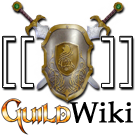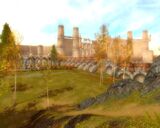Kaede8811@legacy41691732 (talk | contribs) |
|||
| Line 404: | Line 404: | ||
*[[drop rate/Hidden Treasure|Hidden Treasure]] |
*[[drop rate/Hidden Treasure|Hidden Treasure]] |
||
*[[drop rate/Gift of the Traveler|Gift of the Traveler]] |
*[[drop rate/Gift of the Traveler|Gift of the Traveler]] |
||
| + | *[[drop rate/Gift of the Huntsman|Gift of the Huntsman]] |
||
<br /><br /> |
<br /><br /> |
||
Revision as of 21:13, 27 April 2009
DISCLAIMER: The information in this article is based on experimental research conducted by the community, and may contain inaccuracies and speculation. While we strive for accuracy in these articles, we make no claims of experimental rigor or unbiased conclusions. Caveat lector.
Drop rate is a term defined in this wiki (not by ANet) to refer to the patterns that govern how drops occur. There are two sides to studying drop rates in Guild Wars:
- How often does a certain type of loot drop?
- What kind of drops does a certain creature drop and what is the rate of each?
The main focus of studying drop rates of loot is obviously farming. Successful farming is not just based on having the best build to successfully kill and survive, but also, killing the right monsters that produce the desired loot as quickly as possible.
An example of this, is farming Ecto. Most farming groups farm the Smite Crawlers, while actual statistical data shows that the Bladed Aatxe drop Ectos at twice the rate.
The specifics of how a drop rate is determined in-game are unknown. ANet has not published any statistics on any item or monster. Still, basic data can be collected on each monster to record the kind of drops that they leave behind. This data compiled in large amounts can show the rough percentages of the different kinds of loot that a monster drops.
Types of Drops
In general, there are several types of loot that a monster can drop:
- Gold: This actually varies based on the level of monster rather than the type of monster. The higher the level, the higher the amount of gold. Data gathered in high-level areas like the Fissure of Woe, show that the gold dropped varies between 98 gold and 130 gold in those areas. The possibility of gold drops varies sometimes according to area (FoW is less than 10% while UW is more than 25%) and sometimes according to creatures (those that drop armor usually drop gold less frequently).
- Equippable Items: This refers to weapons, shields and focus items. For each species or faction in the game, they will usually have a pattern of dropping items specific to their area (like Shadow Bows in the Fissure or Summit Axes in the Shiverpeaks) and items more general. In addition, a creature will drop items in its own profession fairly often. For example, Smite Crawlers drop a lot of Holy Rods and Smiting Staves while Shadow Beasts drop a lot of Grim Cestas and Deadly Cestas. Equippable items have variations in their rarity.
- Salvage Items: There are two different types of Salvage Items that can be dropped.
- Salvage Armor: More technologically advanced creatures will drop pieces of armor that can be salvaged for crafting material or runes. Examples include the White Mantle, the Charr and Ettins. If a creature drops salvage armor, it will actually drop it at a fairly high rate. Notable exceptions include the Shadow Army and the Skeleton Army. Salvage armor does not stack in the inventory. Salvage armor does have variations in its rarity.
- Salvageable Remains: Some races will drop remains that are marked as "salvage items". Unlike Salvage Armor, these remains stack in the inventory like collectable drops. These include hides, spider webs, and half-eaten masses. These remains drop from creatures that drop armor and creatures that do not. For example, the Charr drop Charr Carvings, Stalker Armor and Charr Hides while a Maguuma Spider drops an Ebon Spider Leg and a Maguuma Spider Web.
- Crafting Material: Creatures that do not drop salvage armor will instead drop crafting material (though at a lesser rate). The majority of the materials dropped will be common crafting material but there is a small chance that a creature will drop rare crafting material. This chance apparently increases as the creature's level increases. Some groups drop both crafting materials and salvage armor; such as Avicara and the Undead found in Kryta.
- Collectable Drops: Almost all creatures in the game have a stackable collectable drop that they leave behind at a fairly consistent rate. Examples include Mursaat Tokens, Hardened Humps and Charr Carvings. This rate is found to be around 20% for most creatures that do have collectable drops. Creatures that do not drop collectable drops include Ancient Skales and Doubter's Dryders.
- Keys: Each creature has a very small chance of dropping a key. The key the creature drops is the key of the area that creature is originally from. Thus, Banshees in the Fissure of Woe drop Phantom Keys because they are originally from the Underworld. Creatures in Hard Mode drop Lockpicks instead of keys.
- Dyes: All creatures have a chance of dropping dye. The chance of a specific dye dropping varies depending on color with black being very rare and orange being very common.
- Nothing: There is a chance that a creature will drop nothing. The probability of this happening early on in an outing into an explorable area is high and drops quickly as players delve into the area and kill more monsters. This seems to occur most when repeatedly solo farming the same area, some of the first 5 or so kills each trip will yield no drop.
Party Size and Drop Rate
With the addition of loot scaling (20 April 2007 Update) the party size only affects the drop rate of items exempt from Loot Scaling. The drop rate on all other items is scaled so that a solo farmer will receive approximately the same number of non-exempt items (blue rarity, collectable items, etc.) as a character in a party of eight people.
Hard Mode
It is currently unknown how Hard Mode affects drop rates. The drop rates for Hard Mode are tracked in a separate table from Normal Mode on the same creature drop rate page.
The Project
This article is the cover page of a project to document each and every creature in Guild Wars in term of their Drop Rates. Users who wish to contribute to this project should follow the following steps:
- Please, create a user name as it will make tracking the sources of the data much more efficient.
- Create a spreadsheet for monitoring the creature you wish to gather Drop Rate data about. The format should be like this:
| Creature | Gold | Equippable Items | Salvage Armor | Common Materials | Rare Materials | Keys | Collectables | Dyes | Nothing | Total | Signature | |||
|---|---|---|---|---|---|---|---|---|---|---|---|---|---|---|
| G | P | B | W | |||||||||||
| Blessed Griffon | 8 | 0 | 0 | 1 | 0 | 0 | 0 | 0 | 1 | 1 | 0 | 24 | 35 | Fox Bloodraven 05:12, 28 November 2006 (CST) |
| Blessed Griffon | 9 | 0 | 0 | 2 | 1 | 0 | 0 | 0 | 0 | 0 | 0 | 18 | 30 | Fox Bloodraven 06:58, 28 November 2006 (CST) |
- Record the drops after each kill of this specific monster. If the monster appears at different levels (like Charr and Grawl), then record the data of each level separaterly.
- Do not record drops from bosses. Their drops and the drops of their species/factions are not always the same.
- Create (or edit) the page for the monster as a sub-article of this article. For example, for the Blessed Griffon above, the data article would be: drop rate/Blessed Griffon. Use the notes section to record any anomalies in the drops of the monster. If you created the article, please list add it to the list below.
- If a sub-article already exists for a monster then do not overwrite the numbers. Instead, add your numbers in a new row to the table then update the totals and percentages at the end of the table. This will increase the data available and prevent addition mistakes that alter the data. You should sign next to the row you add using ~~~~.
- Once enough data has been collected (200+ total drops), then the monster's page can be updated with a section titled Drop Rates that lists the percentages of each drop. For examples, see Bladed Aatxe and Smite Crawler.
- Hard Mode drop rates should be recorded separately from Normal Mode (i.e. create different tables for Normal Mode vs Hard Mode). For example, see drop rate/Hulking Stone Elemental
The hope is that with this project, players can make informed decisions instead of following rumors about drops.
See User:RolandOfGilead/Java/Drop Rate Tool for a Java program that simplifies the task of recording drop rates.
Monster drop data
This is a list of sub-articles containing data collected so far, sorted by region:
Core
The Underworld
|
The Fissure of Woe |
Prophecies
Pre-Searing Ascalon
|
Ascalon |
Northern Shiverpeaks
|
Kryta | ||
Maguuma Jungle |
Crystal Desert |
Southern Shiverpeaks |
Ring of Fire Islands
|
Factions
Shing Jea Island |
Kaineng City |
Echovald Forest |
Jade Sea
|
Nightfall
Istan |
Kourna and Vabbi |
The Desolation
|
Realm of Torment |
See also: Template:Drop Rate Table for creating Drop Rate Tables.
Chest drop data
Part of this project is that we are also recording the quality and type of drops that fall from chests. In this we are trying to understand the likelihood of getting good drops from chests:
Prophecies Chests
|
Factions Chests |
Nightfall Chests
|
Related Articles
- Template:Drop Rate Table for creating Drop Rate Tables.
- Category:Drop rates data
- Drop rate/Locked Chest







